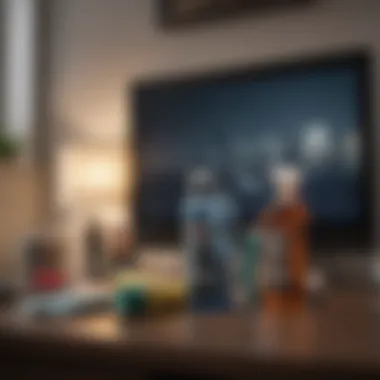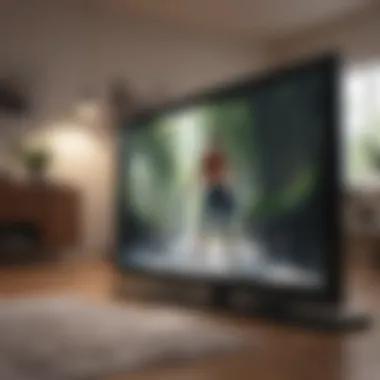Essential Tips for Cleaning LED TV Screens Effectively


Intro
Cleaning an LED television screen requires careful consideration to avoid damaging the display. The purpose of this guide is to delve into the specifics of effective cleaning methods while maintaining the screen's integrity. Understanding the materials and techniques can prolong the life of your television and enhance viewing experiences. Furthermore, insights into necessary precautions will empower readers to act confidently in maintaining their screens.
Importance of Cleaning LED TV Screens
Keeping LED TV screens clean is more than just aesthetic. Dust and fingerprints can hinder image quality, making it harder to enjoy your favorite shows or movies. Regular cleaning also prevents the buildup of grime, which can cause permanent damage over time. It is thus crucial to adopt proper cleaning practices right from the start.
Understanding LED Television Screens
Understanding LED television screens is crucial for maintaining their performance and extending their lifespan. An LED TV utilizes light-emitting diodes for backlighting, improving brightness and contrast compared to older models. A clear grasp of this technology not only helps in selecting the right cleaning methods but also minimizes the risk of damage during maintenance.
LED screens are sensitive to dust, fingerprints, and smudges. Recognizing the importance of regular cleaning enhances the viewing experience significantly. The clarity of the screen impacts not just aesthetics but also the functionality of the television. For a discerning audience, a deep understanding of LED technology is fundamental.
Technology Behind LED Screens
LED technology marks a substantial advancement in the realm of televisions. Unlike traditional LCDs that rely on fluorescent backlighting, LED screens employ tiny diodes to produce light. This technology allows for higher efficiency, deeper blacks, and a broader spectrum of colors. Each pixel in an LED screen can adjust its brightness independently, which results in improved contrast and sharper images.
Furthermore, LED panels come in various forms, including OLED (Organic Light Emitting Diode) and QLED (Quantum Dot LED). Each variety represents unique characteristics that can affect cleaning techniques and product usage. Selecting the incorrect method or product risks not only the clarity but also the internal functioning of the device.
Common Issues Affecting Screen Clarity
Various issues can compromise the clarity of an LED screen, most of which stem from improper cleaning practices or environmental factors. Fingerprints, dust, and smudges are common culprits that hinder visibility. Watching television with a dirty screen can lead to eye strain and diminish the overall experience.
Additionally, accumulated dust can obstruct the ventilation of the device, leading to overheating over time. This can cause further issues in picture quality, and in severe cases, internal damage may occur. Hence, understanding these common issues is the first step towards implementing effective cleaning practices.
Importance of Regular Cleaning
Maintaining the cleanliness of LED television screens is crucial. Dust, fingerprints, and smudges accumulate over time and can affect the overall quality of the viewing experience. Regular cleaning is not just about aesthetic appeal; it has practical implications for the longevity and function of the screen itself. When viewers consistently engage with their screens without taking care of them, they may unintentionally diminish the quality of their experience.
Benefits of Keeping Screens Clean
There are several key benefits to regular cleaning of LED screens:
- Enhanced Image Clarity: A clean screen allows for sharper images and colors. Dirt and grime can obscure display quality, leading to a less enjoyable viewing experience.
- Improved Lifespan: By regularly cleaning screens, users can reduce the build-up of debris that might contribute to screen degradation over time. Keeping the screen free from dust can help maintain its performance.
- Health Considerations: Screens can harbor allergens and dust particles, which can contribute to respiratory issues. Regular cleaning removes these irritants, promoting a healthier environment in the home.
"A simple cleaning routine not only improves picture quality but also contributes to a healthier viewing experience."
Impact on Viewing Experience
The impact of keeping LED television screens clean extends beyond surface aesthetics. Here are a few points to consider:
- Viewing Comfort: A clean screen reduces glare, making it easier to watch TV for extended periods. Unobstructed images are less straining for the eyes.
- Value Retention: Regular maintenance can help retain the value of television sets. When it comes time to sell or upgrade, potential buyers are likely to be more interested in well-maintained products.
- Consistent Performance: Dust and smudges can cause disruptions in performance, such as uneven brightness or contrast. Regular cleaning can mitigate such issues and ensure a more consistent viewing experience.
In summary, the importance of regular cleaning of LED television screens cannot be overstated. It plays a significant role in enhancing image quality, improving the longevity of the screen, and maintaining a healthy viewing environment.
Essential Tools and Materials
Understanding the essential tools and materials for cleaning LED television screens is crucial when trying to maintain their performance and appearance. This section delves into specific items needed for the cleaning process, highlighting their importance and the benefit they bring to effective screen care. Selecting the appropriate tools not only aids in achieving a clear screen but also minimizes the risk of damage that can occur through improper cleaning methods.
Microfiber Cloths


Microfiber cloths are vital for safely cleaning LED screens. Their unique fibers are fine enough to capture dust, fingerprints, and smudges without scratching the screen surface. Unlike traditional cloths, microfiber cloths do not leave lint behind, which can be crucial for maintaining a clear view. These cloths can be washed and reused, making them an economical and environmentally friendly choice.
When using a microfiber cloth, it is important to ensure that it is dry or slightly dampened with a suitable cleaning solution. This avoids any streaks that can occur if the cloth is too wet. Investing in high-quality microfiber cloths will yield better cleaning results and prolong the lifespan of the cloth itself.
Screen Cleaning Solutions
Choosing a proper screen cleaning solution is essential for effective cleaning. Standard household cleaners often contain ammonia or solvents, which can damage the anti-reflective coating on most LED screens. Therefore, it is advisable to use solutions specifically formulated for electronics.
Many of these specialized cleaners are alcohol-free and gentle on surfaces, making them ideal for regular use. It is also crucial to follow the instructions provided by the manufacturer to achieve optimal results and avoid damage. Over time, using the right cleaning solution will help maintain the screen's clarity and color accuracy.
Additional Materials
Distilled Water
Distilled water is a recommended addition for cleaning materials. It is free from minerals and impurities found in tap water, which can leave behind spots or streaks on the screen. Because it evaporates quickly, distilled water reduces the chance of water damage to sensitive components.
For best results, mixing distilled water with a small amount of a screen-cleaning solution can enhance its effectiveness. This combination is often more efficient at removing fingerprints and dust without the risk of discoloration.
Spray Bottles
Using a spray bottle is a practical approach to apply the cleaning solution evenly on the screen. It allows for a fine mist that effectively covers the surface without oversaturating it. A good spray bottle should have an adjustable nozzle, permitting control over the amount of solution released.
This feature is essential during the application since too much liquid can run down to the edges of the screen, leading to potential damage. Cleaning with a spray bottle gives a gentle misting that ensures coverage while preserving the electronic components.
Soft Brushes
A soft brush can assist in reaching delicate areas around the edges of the screen. They are advantageous for removing dust that gathers in crevices where cloths cannot reach. These brushes typically have bristles that are soft enough to avoid scratching the surface.
Their gentle application eliminates the need for excessive pressure that might lead to further damage. Soft brushes also help in keeping the screen dust-free, enhancing the overall cleaning process, especially in homes with pets or in dusty environments.
Step-by-Step Cleaning Process
Cleaning an LED television screen requires a meticulous approach to ensure both efficiency and effectiveness. This step-by-step process is integral to maintaining the screen's clarity and extending its lifespan. By breaking down the cleaning task into manageable steps, users can follow a systematic method that minimizes the risk of damage while maximizing results. Each element of this process plays a crucial role in achieving a pristine screen, and adherence to these steps will lead to a more enjoyable viewing experience.
Preparation Steps
Before diving into the actual cleaning, it is crucial to prepare adequately. This preparation sets the stage for an effective cleaning, safeguarding the television from potential harm.
Turn Off the Television
Turning off the television is a fundamental part of the preparation. Not only does this ensure safety by reducing the risk of electric shock, it also allows for the screen to cool down. A warm screen can lead to damage when exposed to cleaning solutions or harsh materials. This action is a simple yet effective choice for reducing glare, improving visibility of dirt or smudges, and preventing any accidental activation of the TV during cleaning. Overall, turning off the television is a necessary step that provides clear benefits in the cleaning process.
Unplug the Device
Unplugging the device is another essential step in preparation. This step adds an extra layer of safety, helping to eliminate any risk of electric shocks. It also prevents the television from turning on unexpectedly during the cleaning process. Moreover, unplugging the device is particularly important if any moisture comes into contact with the electronic components. While it may seem like a minor detail, neglecting to unplug can lead to severe consequences for the device's functionality. Thus, it is a wise and measured choice to include this in the initial preparations when cleaning the screen.
Cleaning Technique
The cleaning technique is critical to ensuring that the screen is not only clean but also unblemished by scratches or residues. Adopting the right technique can make a significant difference.
Gently Wipe the Screen


Gently wiping the screen is an effective method that avoids applying excessive pressure, which could damage the screen. This technique ensures that dust and fingerprints are removed without risking the integrity of the display. Using a microfiber cloth is highly recommended here, as its softness allows for the safe removal of debris. This gentle action is a practical approach that helps maintain screen quality and prevents scratches, making it a preferred method in this article. Its ease makes it suitable for regular cleaning routines.
Avoid Circular Movements
Avoiding circular movements is crucial when cleaning LED screens. Circular motions can cause streaks and are less efficient in removing smudges than a straight motion. Streaks can detract from the overall viewing experience by leaving behind residual marks. Therefore, using straight, horizontal or vertical strokes enhances both the efficacy and outcome of the cleaning process. The focus on no circular movements is a smart guideline that promotes optimal clarity, avoiding imperfections that could interfere with screen performance.
Focus on Stubborn Spots
Sometimes, dirt does not come off easily. Focusing on stubborn spots is essential for comprehensive cleaning. Dedicate a few moments more to problematic areas, such as greasy fingerprints or dust accumulation. Gently applying slightly more pressure or adding a few drops of cleaning solution can be effective. However, care must be observed to avoid damaging the screen. This particular attention to detail is very important in achieving a thoroughly cleaned television, enhancing both its appearance and functionality.
Finishing Touches
Once the main cleaning is done, it's time to focus on the finishing touches—these steps can make a significant difference.
Check for Residues
After cleaning, checking for residues is a key step. Any leftover cleaner could impair future viewing and attract more dust. Residues might also lead to streaks over time. A second inspection allows for any missed areas to be addressed, ensuring the screen is completely spotless. This diligence is an important characteristic of the cleaning process, reinforcing the importance of thoroughness.
Reassemble and Power On
Finally, reassembling and powering on the device is the last critical step. It should only occur after ensuring the screen is completely dry and free of any cleaning products. Switching the television back on is generally an exciting moment, indicating successful maintenance. This step, while straightforward, is crucial as it signifies the conclusion of the cleaning process and readiness for use. Ensuring all components are correctly in place before powering on safeguards the longevity and effectiveness of the device.
By following these steps diligently, you can maintain not only a clean screen but also ensure its functionality over a long period.
Precautions to Consider
To maintain the integrity and performance of LED television screens, certain precautions must be considered. Failing to follow these guidelines can lead to unintended damage, resulting in costly repairs or replacements. This section aims to delve into crucial aspects that readers should be mindful of while cleaning their screens, emphasizing key characteristics and benefits they contribute to the overall maintenance process.
Avoiding Damage to the Screen
Do Not Use Abrasive Materials
One of the primary factors in maintaining the quality of an LED television screen is avoiding abrasive materials during the cleaning process. Using rough fabrics, scouring pads, or cleaning agents with harsh chemicals can cause irreversible scratches. These scratches can distract from picture quality and diminish the aesthetics of the device.
The key characteristic of avoiding abrasive materials lies in their soft texture. Microfiber cloths, for instance, are a popular choice because they effectively catch dust and grime without harming the screen surface. This offers the added benefit of reducing the risk of creating new scratches while ensuring a thorough clean.
Moreover, while abrasive materials may seem effective at removing stuck-on dirt, they pose a significant risk of damage. Opting for gentler options helps preserve the screen’s functional life, which is vital for a seamless viewing experience.
Keep Liquids Away from Edges
Another essential precaution is to keep liquids away from the edges of the screen. Even minor spills can seep into the cracks and crevices, potentially leading to internal damage and malfunction of the television. The key characteristic of this practice is its preventive nature; by minimizing moisture exposure, you significantly reduce the risk of long-term damage.
This principle becomes particularly important when using spray solutions. Spray solutions should be applied to the cleaning cloth instead of directly onto the screen. This method reduces the chance of liquid dripping into sensitive areas. A unique feature of this approach is that it allows for controlled application, ensuring that you clean effectively without compromising the safety of the device.
Understanding Manufacturer Warranties
Understanding and adhering to manufacturer guidelines is critical for preserving warranties on LED televisions. Many warranties include specific terms regarding cleaning and maintenance practices. This knowledge can safeguard consumers against potential voiding of coverage due to improper care.
Being well-informed about the manufacturer’s recommendations enables users to clean their screens without risking warranty violations. This consideration is particularly beneficial for new or high-end models, where repair costs can be significant. Therefore, it is advisable to refer to the user manual or official customer support resources when unsure about a cleaning method.
"Proper maintenance not only enhances the viewing experience but also extends the lifespan of your LED television, as manufacturers intended."


In summary, recognizing the importance of these precautions assists readers in preserving their high-quality electronics. Committing to careful practices will undoubtedly extend the longevity of LED televisions while ensuring an optimal visual experience.
Alternatives to DIY Cleaning
In the quest for a pristine LED television screen, many individuals consider cleaning methods that can sometimes lead to unintentional damage or ineffective cleaning. For those who are uncertain about how to properly maintain their screen, seeking professional services or specialized products can be a wise choice. Understanding the alternatives to DIY cleaning is essential, as it informs users about the safest and most effective options available, preserving the screen’s clarity and lifespan.
Professional Cleaning Services
Professional cleaning services offer an expertise that most individuals may lack. Technicians trained in handling various types of screens are able to identify specific cleaning needs based on the screen’s material and condition. These professionals use specialized tools and products designed specifically for screens, which reduces the risk of scratches or damage that can occur with amateur efforts.
The advantages of hiring experts are numerous:
- Experience: They know the ins and outs of cleaning electronics without causing harm.
- Equipment: High-quality, industry-grade tools can often achieve better results than household options.
- Time-Saving: Outsourcing the task frees up personal time for other activities.
However, there are drawbacks to consider. The cost of hiring professionals can be significant, especially for recurring services. Additionally, there can be wait times based on the availability of local technicians or services. Thus, while professional cleaning can be beneficial, one must weigh the costs against the need for specialized care.
Recommendations for Products
In lieu of hiring professionals, utilizing recommended cleaning products can be an effective alternative. Two categories of cleaning solutions stand out: eco-friendly cleaners and specialist solutions for electronics. Both serve different needs, meeting the diverse preferences of users.
Eco-Friendly Cleaners
Eco-friendly cleaners are gaining traction among environmentally-conscious consumers. These products are typically biodegradable and free from harmful chemicals, resulting in a reduced impact on the environment. One key characteristic that makes eco-friendly cleaners a popular choice is their availability. Many consumers find them easily accessible at local stores or online.
The unique feature of these cleaners is their gentle formulations. They effectively remove dust and smudges without the risk of damaging the screen’s surface. This aspect is particularly appealing to those looking to maintain a safe home environment, especially families with children or pets. However, one must recognize that while these cleaners are effective for regular maintenance, they may not be suitable for deeper cleaning when more stubborn stains or grime are present. Overall, eco-friendly cleaners provide a balance between effectiveness and environmental responsibility.
Specialist Solutions for Electronics
Specialist solutions for electronics are specifically formulated to clean devices without leaving any residues or streaks. The key characteristic here is their ability to address the unique issues faced by electronic screens. These solutions often come in various forms, including sprays and wipes, making them versatile and easy to use.
The unique feature of specialist cleaners is their anti-static properties, which help reduce the buildup of dust over time. This is beneficial for maintaining a clean screen in environments prone to dust and particles. However, it’s important to be cautious and verify that these products are indeed suitable for LED televisions, as not all types of electronics cleaners are designed for every screen. The right choice can significantly enhance the overall cleanliness and viewing experience.
In summary, while DIY cleaning might seem appealing, exploring alternatives such as professional services or specialized products can yield better outcomes, ensuring the longevity and clarity of your LED television screen. Assessing your specific needs and preferences will guide you to the right solution.
Epilogue: Maintaining Screen Longevity
Maintaining the longevity of LED television screens is not merely an ancillary concern; it is vital for ensuring optimal performance and durability. A well-kept screen not only enhances viewing experiences but also contributes to the overall lifespan of the device. As technology advances, more people prefer LED TVs for their superior image quality, energy efficiency, and sleek design. However, neglecting the cleaning aspect can result in diminished visual clarity and potential long-term damage.
Establishing a Cleaning Routine
Establishing a consistent cleaning routine is an effective strategy to maintain screen clarity. Regular cleaning prevents the build-up of dust, fingerprints, and smudges, which can obscure picture quality. Ideally, this routine should include a gentle cleaning process done once a week.
- Start with a soft microfiber cloth to avoid scratching the surface.
- Lightly dampen the cloth with a suitable cleaner, avoiding direct application to the screen.
- Wipe in straight lines to eliminate streaks, focusing on the edges and corners where dust collects.
- Always ensure the television is off and unplugged during the cleaning process to stay safe and make it easier to see any spots.
This structured approach not only helps to keep the screen clear but also extends the life of the LED display by protecting it from scratches and surface damage.
Impact of Environment on Screen Cleanliness
The environment plays a significant role in how quickly screens accumulate dirt and dust. Factors like humidity, smoke, and even the presence of pets can affect the screen's overall cleanliness. In a home with high humidity, the moisture can attract dust particles, leading to more frequent cleanings.
Consider the following:
- Humidity Levels: High humidity can cause a sticky residue to form, requiring more frequent cleaning.
- Pet Owners: Fur and dander can settle on screens, making routine maintenance essential.
- Location: Screens in active living spaces may gather dirt more quickly compared to those in lesser-used rooms.
By understanding and acknowledging these environmental factors, one can tailor a cleaning schedule that ensures the screen remains clear and functional.
Regular maintenance not only promotes better viewing experiences but also safeguards the investment made in the television.







